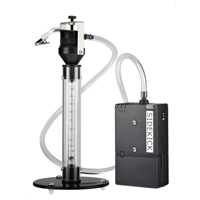Air Sampling Glossary
Glossary of Terms for Air Sampling
TWA – TWA means Time-Weighted Average and is the average exposure to a condition or contaminant (such as gases and vapours) to which a worker can be exposed to without adverse effect over a period of time such as an 8 hour day or a 40 hour week. This should not be confused with the concentration of a substance, which is not time-dependent.
STEL – STEL means Short-Term Exposure Limit and is the acceptable average exposure over a short period of time. It usually means 15 minutes and as long as the TWA isn’t exceeded.
ATEX – It consists of two EU directives which describe what equipment and work environment are allowed in an area with an explosive atmosphere when doing air sampling.
Parameter – Used to identify a feature, characteristic or a measureable factor that can help to define a particular system.
RFI/EMI – RFI stands for Radio Frequency Interference and is the same thing as EMI which stands for Electromagnetic Interference.
Lexan – It is a transparent plastic (polycarbonate) which has high impact strength.
OSHA – Occupational Safety and Health Administration. This is the American Government’s Safety at Work organisation
NIOSH – The National Institute for Occupational Safety and Health. This is the American society for industrial hygienists.
Haz-Mat – They are also called Hazardous Materials and are dangerous goods such as solids, liquids and gases that can harm people or other living organisms.
ACGIH – The American Conference of Governmental Industrial Hygienists
ISO – The International Standards Organization
CEN – The European Committee for Standardization
UL Approval – Underwriters Laboratories is an independent product safety certification organization and is responsible for ATEX approvals in the USA.
COSHH – The Control of Substances Hazardous to Health Regulations 2002 is a UK regulation that states the general requirements on employers to protect employees and other people from the hazards of substances used at work by risk assessment, control of exposure, health surveillance and incident planning. This means that air sampling is required to measure and monitor these substances.
NIST – The National Institute of Standards and Technology in the USA
Rotameter – A device that measures the flow rate of liquid or gas in a closed tube. This is used for calibrating the flow-rate of a sample pump for personal exposure air sampling
Microprocessor – An integrated circuit that contains all of the functions of a central processing unit of a computer.
Bubble-film Calibrator – A device for calibrating personal sampling pumps that are to be used for gas or vapour collection. Sampling for gases and vapours requires a comparatively low flow rate to dust sampling and therefore the calibration method must be suitable. A ‘bubble’ or ‘film’ is created using a soap solution in the pathway of the air-flow. The time taken for this film to move up the glass tube is measured, giving the volume of air moved in one minute.
Sorbent Tube – They sample hazardous gases and vapours in the air and mostly relates to Industrial Hygiene. They were developed in the USA for Air Quality Testing of Workers. They are typically made of glass and contain various types of solid absorbent material. Solid Sorbents are chosen for sampling specific compounds in the air because they trap and retain compounds of interest even in the presence of other compounds. They do not alter the compounds of interest and allow collected compounds to be easily deabsorbed or extracted for analysis.
Filter Paper – A semi-permeable paper barrier which is placed perpendicular to air flow. It is used to separate fine solids from air. Filter paper comes in various porosities and grades depending on the application it is meant for.
IOM Sample Head – A reusable filter cassette with a sampling head designed to better measure the workers exposure to total airborne particulates.
Cyclone Sample Head – It separates out respirable dust fraction from the total inhalable dust to allow the collection of respirable dust on to a filter.
Parallel Particle Impactor – The Parallel Particle Impactor contains four impactors which are arranged in parallel and each of them have a different 50% cut point which targets a specific segment of the selected convention. The personal sample pump provides a 2 L/min or 8L/min flow to operate each Impactor simultaneously, but independently. The sample is collected on a single 37mm filter and is analyzed gravimetrically to provide a respirable or thoracic result which is closer to the entire range of the selected convention than any other sampler available.
Total Inhalable Dust Fraction – The fraction of dust that enters the nose and mouth and may be deposited anywhere in the respiratory tract.
Thoracic Fraction – The fraction that enters the Thorax and is deposited within the lung airways and the gas exchange regions.
Respirable Fraction – Deposited in the gas exchange regions (alveoli) of the lungs
-

Castle Products
CLICK HERE FOR
Information, technical data, images and pricing of all Castle Group Ltd. products -

Product Rental
CLICK HERE FOR
Hire the best equipment at a fraction of the purchase price -

Calibration Lab.
CLICK HERE FOR
Calibration and repair services from Air Samplers to Vibration Meters -

Training
CLICK HERE FOR
World class safety and environmental courses. On your site or our 4* training facility -

Consultancy
CLICK HERE FOR
Employ our expertise for both simple and more demanding issues.













